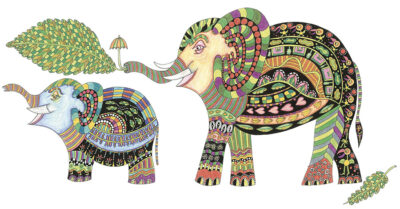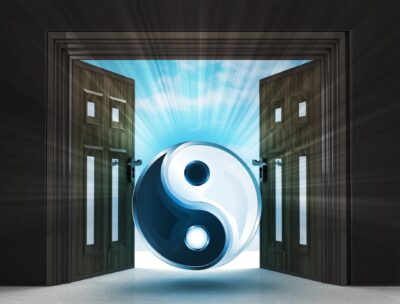
When you walk or drive down a city street, what you are seeing all around you are manifestations of thoughts. Every building began as an idea in somebody’s mind.
Someone acquired the land. Someone designed the house. Someone had the idea to organize people together to build the house, either to make money or to live in it. The trees you see were planted for shade in the yard, on the sidewalk, along the street. The pavement that we accept as a natural part of our landscape was conceptualized, designed, engineered, installed, and is maintained via thought.
Thoughts create our physical reality, and they also create our larger reality. During ancient times, when there was an electrical storm, people perceived the thunder and lightning as the voice of a powerful deity.
If somebody got hit by lightning, that proved to others that the person had committed some crime or displeased the deity. When the thunder rumbled loudly nearby, people knelt to the ground and cried out their prayers.
They knew, when they saw the awesome streaks of light across the sky, that they were seeing the finger of their god writing messages or expressing an opinion. Today thunder and lightning are seen and heard as the discharge of electrical energy between ions in the air and the oppositely charged ground.
If somebody is struck by lightning, it is either due to their own stupidity (standing on the golf course with a club in the air) or just bad luck. If the storm is severe, we take cover out of fear of a dangerous natural phenomenon, rather than a wrathful god.
The same event creates a completely different feeling, thought, and behavior in the people who observe it today. The point is, the experience of reality is different, and what makes it different is thought.
A few years ago, I spoke at a conference sponsored by Hebrew University in Jerusalem. After the presentation, my wife, Louise, and I went for a walk through the Old City, down through the Arab Quarter where most of the tourist shops are.
It was a Friday, the Muslim Sabbath, but not being Islamic, we doubted this would affect our sightseeing and shopping. It being a very hot May day, Louise was wearing a comfortable pair of walking shorts. As we moved through the streets, one shopkeeper came out of his store and started shouting at Louise, calling her a “Western pig,” a “whore,” and a “blasphemer.” “Don’t you know it’s a holy day, you bitch?” he screamed. “You have no right to show your legs!”
I mention this culture clash because the shopkeeper’s reality was that a woman (who, in Islam, has a different social status than women in most Western cultures) was flagrantly breaking the law.
Louise’s reality held that it was a hot day in a tourist center and she was dressed comfortably in conservative shorts, according to Western standards, and being harassed for it.
My reality told me that a man was displaying bad manners and disrespect for my culture and religion, for women in general, and for another human being in particular, by shouting instead of quietly coming up to us and presenting his case.
We were all correct.
And so now all of humanity is presented with a dizzying set of conflicting realities. What we choose to do about them will determine our future as a species. Consider these various ideas different people might have about life:
- “We need electricity to be comfortable and maintain our way of life,” or “Producing electricity with fossil fuel is pumping billions of tons of carbon dioxide into the atmosphere, leading to global warming and extremely destructive weather patterns.”
- “Being able to drive where and when we want to at a low cost is freedom,” or “Americans’ driving habits are feeding the destruction of the planet.”
- “All of nature is here to serve the needs of humankind,” or “Humans are no more or less important to the planet than any other life-form.”
These ideas are grounded in the stories — the myths of our culture, our paradigms, our beliefs — that form the core of what we tell ourselves is “reality.” Stories, in this context, are anything we add to our original experience that alters what we think is going on, or changes how we think about things.
Since so much of what we call reality is subjective, there are few right or wrong stories; instead, there are useful and not useful stories. This is dependent upon what culture you belong to, your status in your culture, and your relationship to the natural world and vision of the future.
Increasingly, the stories we’ve been telling ourselves for centuries are now moving from the useful to the not useful category. An example of such a story is the biblical order to have as many children as possible. In the days of Noah and Abraham, the tribe with the largest number of young men to create an army was usually the tribe that survived.
“Be fruitful and multiply” was a formula for cultural survival, even though in nearly all cases it then led to “and when you run out of resources and living space, kill off your neighbor and take theirs.”
We’ve rationalized this over the years by saying that this conquering and dominating lifestyle has brought us so many good things: television, visiting the moon, modern appliances, the eradication of many diseases.
Back when the planet had only a few million people on it (the world hit a population of 1 billion during the presidency of Thomas Jefferson), a person could probably have built a case for the value of huge families, growing populations, and the conquest of nearby (or distant) lands. It might have been of questionable morality, but it could have been defended by the norms of a culture that had survival and growth as its primary goals and had not yet hit the limits of nature. Now, however, such stories imperil the very culture from which they’re derived.
The ancient Greeks changed the world and established the foundations of Western Civilization with the idea of integrating democracy and the ownership of enslaved people. In fact, every time a culture has been transformed, since or before then and for better or worse, it’s been because of an idea, an insight, a new understanding of how things are, and of what is possible.
Ideas preceded every revolution, every war, every transformation, and every invention.
So, the good news is that if we re-define our cultural norms, re-tell the stories that make up the reality we follow, then humanity’s behaviors actually can change to conform to the new stories. It starts with us!
Original article here


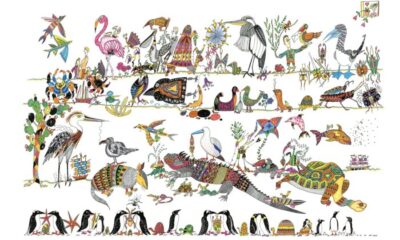

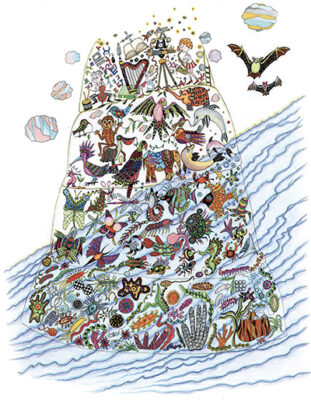
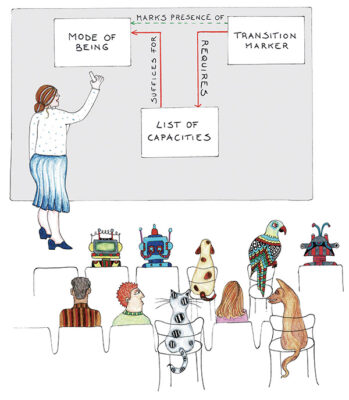 A consensus list of consciousness capacities is a step forward, but identifying each and every capacity may be difficult, and a list does not tell us how they interact to form a conscious being. If we could find a single system-property — an evolutionary marker of consciousness — that indicates that the organism has evolved all the capacities in the consensus list, we would be in a much better position. Finding such a single, diagnostic transition marker would make it possible to identify the simplest evolved conscious being, reconstruct the processes and structures that underlie it, and figure out how they interact. If we can follow the evolution of the marker and therefore the evolution of consciousness, we can discover when and how the conscious mode of being originated.
A consensus list of consciousness capacities is a step forward, but identifying each and every capacity may be difficult, and a list does not tell us how they interact to form a conscious being. If we could find a single system-property — an evolutionary marker of consciousness — that indicates that the organism has evolved all the capacities in the consensus list, we would be in a much better position. Finding such a single, diagnostic transition marker would make it possible to identify the simplest evolved conscious being, reconstruct the processes and structures that underlie it, and figure out how they interact. If we can follow the evolution of the marker and therefore the evolution of consciousness, we can discover when and how the conscious mode of being originated.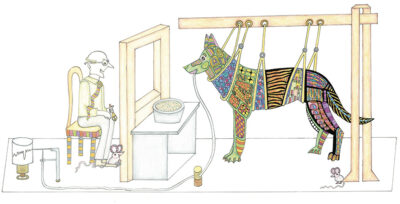
 The study of associative learning today includes the investigation of the underlying cognitive and neurobiological mechanisms in ecologically relevant conditions such as the social conditions in which animals learn from each other. It is a rich and productive research program, which is no longer constrained by the behaviorists’ maxims. There is an irony in our (qualified) return to the 19th-century suggestion that open-ended associative learning is an evolutionary transition marker of consciousness, the very term that behaviorists tried to purge from psychology.
The study of associative learning today includes the investigation of the underlying cognitive and neurobiological mechanisms in ecologically relevant conditions such as the social conditions in which animals learn from each other. It is a rich and productive research program, which is no longer constrained by the behaviorists’ maxims. There is an irony in our (qualified) return to the 19th-century suggestion that open-ended associative learning is an evolutionary transition marker of consciousness, the very term that behaviorists tried to purge from psychology.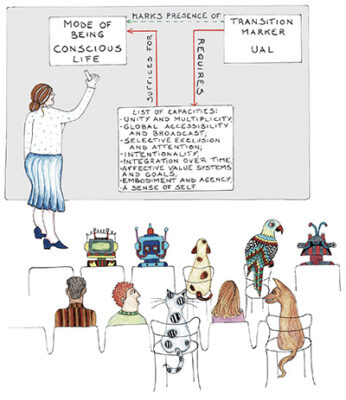 (i) It can distinguish between novel complex patterns of stimuli and actions. For example, it can learn to navigate in a new terrain — to discriminate between different types of animals, between different routes leading to food and shelter. The learned patterns are genuinely novel: they are not reflex-eliciting patterns, nor have they been learned in the past.
(i) It can distinguish between novel complex patterns of stimuli and actions. For example, it can learn to navigate in a new terrain — to discriminate between different types of animals, between different routes leading to food and shelter. The learned patterns are genuinely novel: they are not reflex-eliciting patterns, nor have they been learned in the past. Animals that could mitigate the high costs of UAL without giving up its benefits would have a great advantage. The evolutionary elaboration of the ubiquitous stress response and the evolution of active forgetting are some of the ameliorating mechanisms that we expect to find in all associatively learning animals, and in particular, in UAL animals. Suffering was not eliminated, but it became more controlled.
Animals that could mitigate the high costs of UAL without giving up its benefits would have a great advantage. The evolutionary elaboration of the ubiquitous stress response and the evolution of active forgetting are some of the ameliorating mechanisms that we expect to find in all associatively learning animals, and in particular, in UAL animals. Suffering was not eliminated, but it became more controlled.